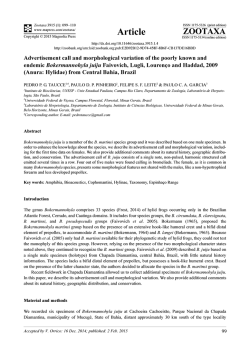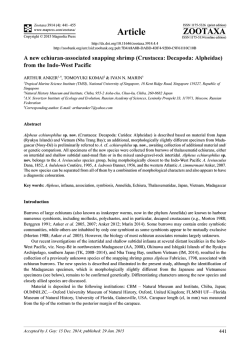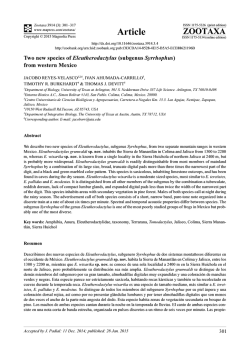
A new species of Rock-Dwelling Scinax Wagler
Zootaxa 3915 (1): 052–066 www.mapress.com /zootaxa / Copyright © 2015 Magnolia Press Article ISSN 1175-5326 (print edition) ZOOTAXA ISSN 1175-5334 (online edition) http://dx.doi.org/10.11646/zootaxa.3915.1.2 http://zoobank.org/urn:lsid:zoobank.org:pub:5F6E2415-726A-478B-8F56-510BFFD19E05 A new species of Rock-Dwelling Scinax Wagler (Anura: Hylidae) from Chapada dos Veadeiros, Central Brazil KATYUSCIA ARAUJO-VIEIRA1,3, REUBER ALBUQUERQUE BRANDÃO2 & DANIELE CARVALHO DO CARMO FARIA2 1 División Herpetología, Museo Argentino de Ciencias Naturales “Bernardino Rivadavia”-CONICET, Ángel Gallardo 470, C1405DJ, Buenos Aires, Argentina. E-mail: [email protected] 2 Laboratório de Fauna e Unidades de Conservação, Departamento de Engenharia Florestal, Universidade de Brasília, Brasília, Brazil. E-mail: [email protected] 3 Corresponding author Abstract A new species of the Scinax ruber clade is described from Chapada dos Veadeiros region, Central Brazil. The new species is diagnosed by having SVL 21.9–27.7 mm in males and 26.7–31.7 mm in females; snout acuminate in dorsal view and rounded in profile; medium-sized tympanum; vocal sac single, median, subgular, that does not reach the pectoral region; iris iridescent yellow, with some thin, darker reticulations; tadpoles with ventral oral disc; P-3 regular and unmodified as a labial arm; absence of keratinized and colored plates on the sides of the lower jaw-sheath; presence of a keratinized and colored spur on each side behind the lower jaw-sheath; dorsolateral eyes, ventrally invisible; and advertisement call composed of 8–14 notes each with 4–18 pulses, and duration of 290–420 ms. The new species uses temporary creeks in rock meadows above 1.000 m a.s.l. and males calls from rock outcrops. The dorsal color pattern enables this species to camouflage in this kind of surfaces. Key words: Scinax rupestris sp. nov., advertisement call, tadpole, brazilian Cerrado, rock-bed rivulets, morphology, taxonomy Introduction Scinax Wagler comprises the most species rich genus of neotropical hylid frogs, with 112 described species (Frost 2014), ranging from Mexico to Central Argentina. The genus comprises two large clades (Faivovich 2002; Faivovich et al. 2005), the S. catharinae and the S. ruber clades. The former comprises 44 species that occur mostly in the Atlantic Forest of SE Brazil, with a few occurring as well in similar habitats in central-eastern Brazil and reaching southwards central-eastern Argentina. Several species of this clade reproduce on streams or headwaters (species in the S. catharinae group; e.g. Duellman & Wiens 1992; Pombal & Bastos 1996; but see Faivovich 2002 for a few exceptions) or on bromeliads (the S. perpusillus group; Peixoto 1986). The S. ruber clade comprises 66 species ranging between Central Argentina and Mexico. These occupy diverse habitats, including both open and forested areas, and most frequently reproduce on temporary or permanent lentic water bodies (e.g. Duellman 1970; Cardoso & Sazima 1980; Pombal et al. 1995a). The study of specimens collected during the 1970s by the late Werner C.A. Bokermann in Chapada dos Veadeiros, Central Brazil, and recent fieldwork on that locality lead to the discovery of a new species of the S. ruber clade that calls from stones along rivulets and streams, and it is described here. Material and methods Adult specimens were fixed in 10% formalin and stored in 70% ethanol. Webbing formula follows Savage & Heyer 52 Accepted by V. Orrico: 16 Dec. 2014; published: 2 Feb. 2015 References Altig, R. & McDiarmid, R.W. (1999) Body plan, development and morphology. In: Tadpole: The Biology of Anuran Larvae. University of Chicago Press, Chicago and London, pp. 24–51. Alves, A.C.R. & Carvalho-e-Silva, S.P. (1999) Descrição da larva de Scinax similis (Cochran) com notas comparativas sobre o grupo “ruber” no sudeste do Brasil (Amphibia, Anura, Hylidae). Revista Brasileira de Zoologia, 16, 507–512. Alves, A.C.R. & Carvalho-e-Silva, S.P. (2002) Descriptions of the tadpoles of Scinax alter and Scinax cuspidatus (Anura: Hylidae). Journal of Herpetology, 36, 133–137. http://dx.doi.org/10.1670/0022-1511(2002)036[0133:DOTTOS]2.0.CO;2 Alves, A.C.R., Gomes, M.R. & Carvalho-e-Silva, S.P. (2004) Description of the tadpole of Scinax auratus (Wied-Neuwied) (Anura, Hylidae). Revista Brasileira de Zoologia, 21, 315–317. http://dx.doi.org/10.1590/S0101-81752004000200026 Barrio-Amorós, C.L. (2004) Amphibians of Venezuela. Systematic list, distribution and references, an update. Revista Ecologica Latino Americana, 9, 1–48. Bilate, M. & Lack, E. (2011) The advertisement call of Scinax similis (Cochran, 1952) (Amphibia, Anura). South American Journal of Herpetology, 6, 54–58. http://dx.doi.org/10.2994/057.006.0108 Bokermann, W.C.A. (1968) Three new Hyla from the Plateau of Maracás, central Bahia, Brazil. Journal of Herpetology, 1, 25–31. http://dx.doi.org/10.2307/1563259 Bokermann, W.C.A. (1969) Notas sobre Hyla aurata Wied, 1824 (Anura, Hylidae). Revista Brasileira de Biologia, 29, 159–162. Brandão, R.A. (2002) A new species of Phyllomedusa Wagler, 1830 (Anura: Hylidae) from Central Brazil. Journal of Herpetology, 36, 571–578. http://dx.doi.org/10.1670/0022-1511(2002)036[0571:ANSOPW]2.0.CO;2 Brandão, R.A., Álvares, G.F.R. & de Sá, R.O. (2013) The advertisement call of the poorly known Leptodactylus tapiti (Anura, Leptodactylidae). Zootaxa, 3616, 284–286. http://dx.doi.org/10.11646/zootaxa.3616.3.6 Caramaschi, U. & Cardoso, M.C.S. (2006) Taxonomic status of Hyla camposseabrai Bokermann, 1968 (Anura: Hylidae). Journal of Herpetology, 40, 549–552. http://dx.doi.org/10.1670/0022-1511(2006)40[549:TSOHCB]2.0.CO;2 Cardoso, A.J. & Sazima, I. (1980) Nova espécie de Hyla do sudeste brasileiro (Amphibia, Anura, Hylidae). Revista Brasileira de Biologia, 40, 75–79. Carvalho-e-Silva, S.P. & Peixoto, O.L. (1991) Duas novas espécies de Ololygon para os Estados do Rio de Janeiro e Espírito Santo (Amphibia, Anura, Hylidae). Revista Brasileira de Biologia, 51, 263–270. Cei, J.M. (1980) Amphibians of Argentina. Monitore Zoologico Italiano (N.S.), Monografia 2, 1−609. De la Riva, I. (1993) A new species of Scinax (Anura, Hylidae) from Argentina and Bolivia. Journal of Herpetology, 27, 41–46. http://dx.doi.org/10.2307/1564903 De la Riva, I. (1990) Una especie nueva de Ololygon procedente de Bolivia. Revista Española de Herpetología, 4, 81–86. Drummond, L.O., Baêta, D. & Silvério-Pires, M.R. (2007) A new species of Scinax (Anura, Hylidae) of the S. ruber clade from Minas Gerais, Brazil. Zootaxa, 1612, 45–53. Duellman, W.E. (1970) The Hylid frogs of Middle America. Monographs of the Museum of Natural History, University of Kansas, 1, 1–753. http://dx.doi.org/10.5962/bhl.title.2835 Duellman, W.E. (1972) A new species of Hyla from Amazonian Ecuador. Copeia, 2, 265–271. http://dx.doi.org/10.2307/1442487 Duellman, W.E. (1986) Two new species of Ololygon (Anura: Hylidae) from the Venezuelan Guyana. Copeia, 4, 864–870. http://dx.doi.org/10.2307/1445281 Duellman, W.E. & Wiens, J.J. (1992) The status of the hylid frog genus Ololygon and the recognition of Scinax Wagler, 1830. Occasional Papers of the Museum of Natural History, University of Kansas, 151, 1–23. Duellman, W.E. & Wiens, J.J. (1993) Hylid frogs of the genus Scinax Wagler, 1830 in Amazonian Ecuador and Peru. Occasional Papers of the Museum of Natural History, University of Kansas, 153, 1–57. Faivovich, J. (2002) A cladistic analysis of Scinax (Anura, Hylidae). Cladistics, 18, 367–393. http://dx.doi.org/10.1016/s0748-3007(02)00001-4 Faivovich, J., Haddad, C.F.B., Garcia, P.C.A., Frost, D.R., Campbell, J.A. & Wheeler, W.C. (2005) Systematic review of the frog family Hylidae, with special reference to Hylinae, phylogenetic analysis and taxonomic revision. Bulletin of the American Museum of Natural History, 294, 1–240. http://dx.doi.org/10.1206/0003-0090(2005)294[0001:srotff]2.0.co;2 Fouquette, M.J. Jr. & Pyburn, W.F. (1972) A new Colombian treefrog of the Hyla rubra complex. Herpetologica, 28, 176–181. Frost, D.R. (2014) Amphibian Species of the World, An Online Reference. Version 5.2. American Museum of Natural History, New York, USA. Available from http,//research.amnh.org/herpetology/amphibia/index.php (accessed 20 May 2014) 64 · Zootaxa 3915 (1) © 2015 Magnolia Press ARAUJO-VIEIRA ET AL. Gosner, K.L. (1960) A simplified table for staging anuran embryos and larvae with notes on identification. Herpetologica, 16, 183–190. Grosjean, S. (2005) The choice of external morphological characters and developmental stages for tadpole-based anuran taxonomy, a case study in Rana (Sylvirana) nigrovittata (Blyth, 1855) (Amphibia, Anura, Ranidae). Contributions to Zoology, 74, 61–76. Heyer, W.R., Rand, A.S., Cruz, C.A.G., Peixoto, O.L. & Nelson, C.E. (1990) Frogs of Boracéia. Arquivos de Zoologia, 31, 231–410. http://dx.doi.org/10.2307/1446606 Lavilla, E.O. & Scrocchi, G.J. (1986) Morfometría larval de los géneros de Telmatobiinae (Anura, Leptodactylidae) de Argentina y Chile. Physis, 44, 39–43. Lenza, E., Pinto, J.R.R., Pinto, A.S., Maracahipes, L. & Bruziguessi, E.P. (2011) Comparação da vegetação arbustivo-arbórea de uma área de cerrado rupestre na Chapada dos Veadeiros, Goiás, e áreas de cerrado sentido restrito do Bioma Cerrado. Revista Brasileira de Botânica, 34, 247–259. Lescure, J. & Marty C. (2000) Atlas des Amphibiens de Guyane. Collections Patrimoines Naturels, 45, 1–388. Lutz, B. (1973) Brazilian Species of Hyla. Austin and London, University of Texas Press, Austin and London, XVIII + 260 pp. Kolenc, F., Borteiro, C. & Tedros, M. (‘‘2003’’ [2004]) La larva de Hyla uruguaya Schmidt, 1944 (Anura: Hylidae), con comentarios sobre su biología en Uruguay y su status taxonómico. Cuadernos de Herpetología, 17, 87–100. Mercês, E.A. & Juncá, F.A. (2012) The tadpole of Scinax juncae Nunes & Pombal, 2010 (Anura, Hylidae). Zootaxa, 3416, 41–43. Myers, C.W. & Duellman, W.E. (1982) A new species of Hyla from Cerro Colorado, and other tree frog records and geographical notes from Western Panama. American Museum Novitates, 2752, 1–32. http://dx.doi.org/10.2994/057.004.0102 Moravec, J., Tuanama, I.A., Pérez-Peña, P.E. & Lehr, E. (2009) A new species of Scinax (Anura: Hylidae) from the area of Iquitos, Amazonian Peru. South American Journal of Herpetology, 4, 9–16. http://dx.doi.org/10.2994/057.004.0102 Nunes, I. & Pombal Jr., J.P. (2010) A new Scinax Wagler (Amphibia, Anura, Hylidae) from the Atlantic Rain Forest remains of southern State of Bahia, north-eastern Brazil. Amphibia-Reptilia, 31, 347–353. http://dx.doi.org/10.1163/156853810791769482 Nunes, I., Carvalho Jr., R.R. & Pereira, E.G. (2010) A new species of Scinax Wagler (Anura: Hylidae) from Cerrado of Brazil. Zootaxa, 2514, 24–34. Nunes, I. & Pombal, J.P. Jr. (2011) A new snouted treefrog of the speciose genus Scinax Wagler (Anura, Hylidae) from northeastern Brazil. Herpetologica, 67, 80–88. http://dx.doi.org/10.1655/HERPETOLOGICA-D-10-00026.1 Nunes, I., Kwet, A. & Pombal, J.P. Jr. (2012) Taxonomic revision of the Scinax alter species complex (Anura: Hylidae). Copeia, 3, 554–569. http://dx.doi.org/10.1643/ch-11-088 Peixoto, O.L. (1986) Espécies bromelígenas do gênero Ololygon: o grupo ‘‘perpusilla’’ (Amphibia, Anura, Hylidae). Ph.D. Thesis, Universidade de São Paulo, Brazil, 161 leaves. Pombal, J.P. Jr. & Bastos, R.P. (1996) Nova espécie de Scinax Wagler, 1830 do Brasil Central (Amphibia, Anura, Hylidae). Boletim do Museu Nacional do Rio de Janeiro, 371, 1–11. Pombal, J.P. Jr., Bastos, R.P. & Haddad, C.F.B. (1995a) Vocalizações de algumas espécies do gênero Scinax (Anura, Hylidae) do sudeste do Brasil e comentários taxonômicos. Naturalia, 20, 213–225. Pombal J.P. Jr.,, Haddad, C.F.B. & Kasahara, S. (1995b) A new species of Scinax (Anura: Hylidae) from Southeastern Brazil, with comments on the genus. Journal of Herpetology, 29, 1–6. http://dx.doi.org/10.2307/1565078 Pugliese, A., Pombal, J.P. Jr. & Sazima, I. (2004) A new species of Scinax (Anura: Hylidae) from rocky montane fields of the Serra do Cipó, southeastern Brazil. Zootaxa, 688, 1–5. Pugliese, A., Baêta, D. & Pombal, J.P. Jr. (2009) A new species of Scinax (Anura: Hylidae) from rocky montane fields in southeastern and central Brazil. Zootaxa, 2269, 53–64. Pyburn, W.F. (1992) A new tree frog of the genus Scinax from the Vaupes River of northwestern Brazil. Texas Journal of Science, 44, 405–411. Pyburn, W.F. (1993) A new species of dimorphic tree frog, genus Hyla (Amphibia: Anura: Hylidae), from the Vaupe´s River of Colombia. Proceedings of the Biological Society of Washington, 106, 46–50. Rivero, J.A. (1961) Salientia of Venezuela. Bulletin of the Museum of Comparative Zoology, Cambridge, Massachusetts, 126, 1–207. Sabaj Pérez, M.H. (2014) Standard symbolic codes for institutional resource collections in herpetology and ichthyology: an Online Reference. American Society of Ichthyologists and Herpetologists, Washington, DC. Version 5.0. Available from: http://www.asih.org/ (accessed 22 September 2014) Savage, J.M. & Heyer, R.W.(1967) Variation and distribution of the tree-frog genus Phyllomedusa in Costa Rica. Beiträge zur Neotropical Fauna, 5, 111–131. http://dx.doi.org/10.1080/01650526709360400 NEW SPECIES OF SCINAX FROM S. RUBER CLADE Zootaxa 3915 (1) © 2015 Magnolia Press · 65 Santoro, G.R.C.C. & Brandão, R.A. (2014) Reproductive modes, habitat use, and richness of anurans from Chapada dos Veadeiros, Central Brazil. North-Western Journal of Zoology, 10, 365–373. Spix, J.B. (1824) Animalia nova sive species novae Testudinum et Ranarum, quas in itinere per Brasiliam annis MDCCCXVII–MDCCCXX jussu et auspiciis Maximiliani Josephi I. Bavariae Regis. Typis Francisci Seraphi Hübschmanni, Monachii, XXXIX + 53pp. http://dx.doi.org/10.5962/bhl.title.3665 Sturaro, M.J. & Peloso, P.L.V. (2014) A new species of Scinax Wagler, 1830 (Anura: Hylidae) from the Middle Amazon River Basin, Brazil. Papéis Avulsos de Zoologia, 54, 9–23. http://dx.doi.org/10.1590/0031-1049.2014.54.02 APPENDIX 1. Adult specimens examined. Scinax baumgardneri: KU 129753 (paratype). S. cabralensis: MNRJ 42884, 42888 (paratypes). S. danae: KU 167089–167090 (paratypes). S. exiguus: KU 167118, 167121 (paratypes). S. karenanneae: UTA-A 3768–3769 (paratypes). S. lindsayi: UTA-A 4301, 4303 (paratypes). S. wandae: KU 131717(paratype). 66 · Zootaxa 3915 (1) © 2015 Magnolia Press ARAUJO-VIEIRA ET AL.
© Copyright 2025




